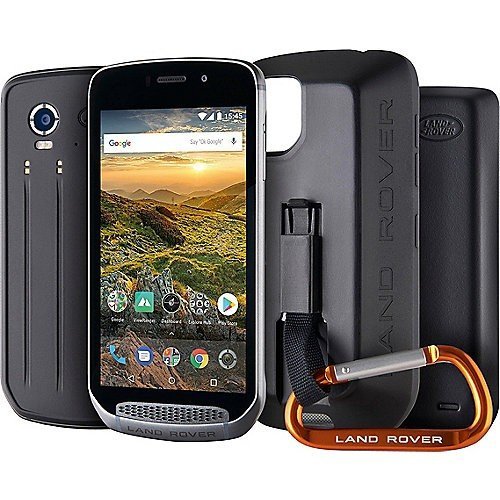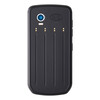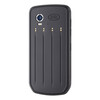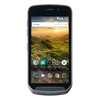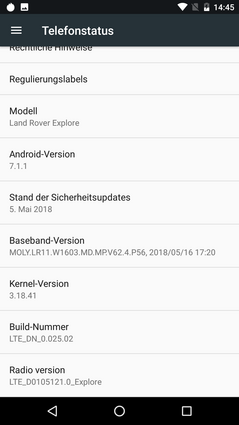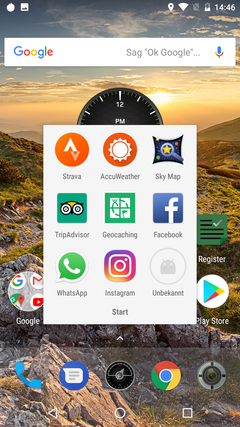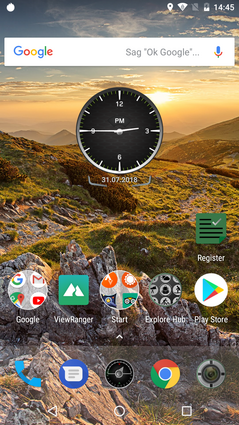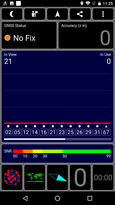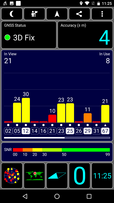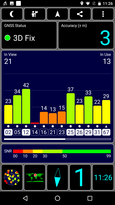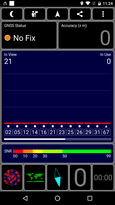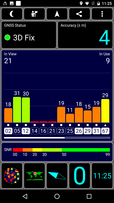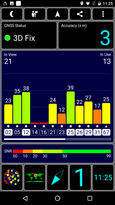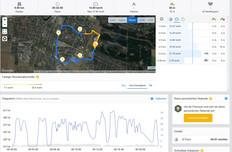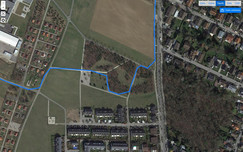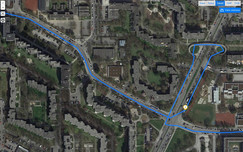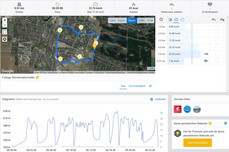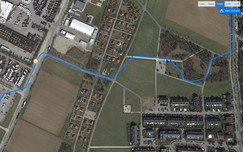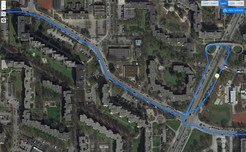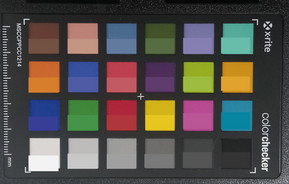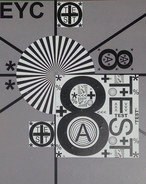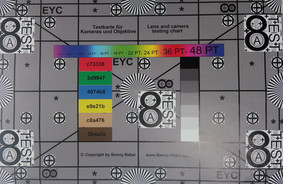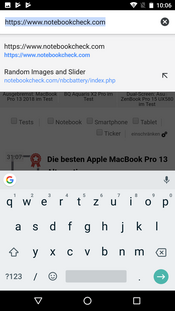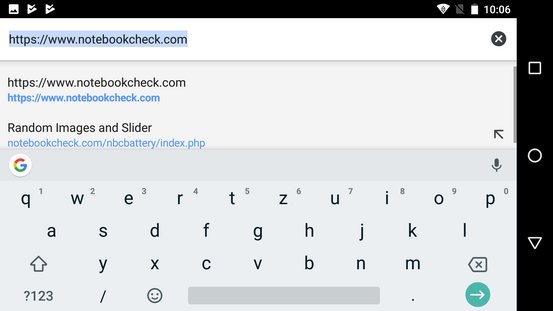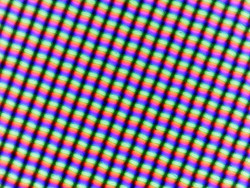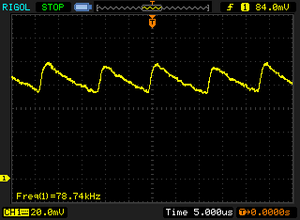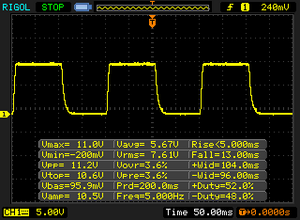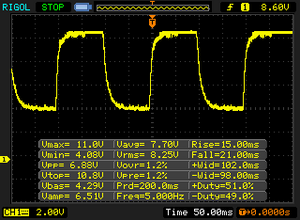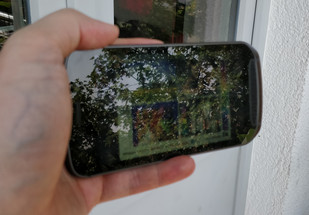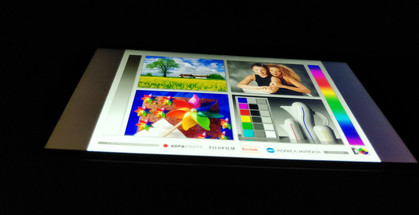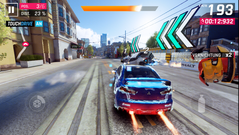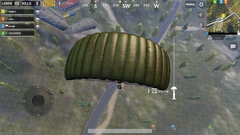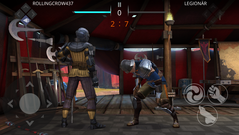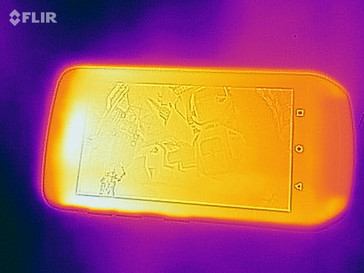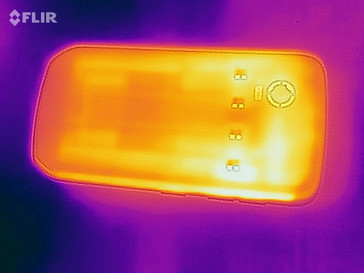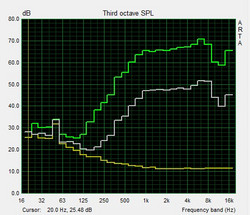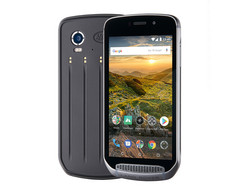Land Rover Explore Smartphone Review
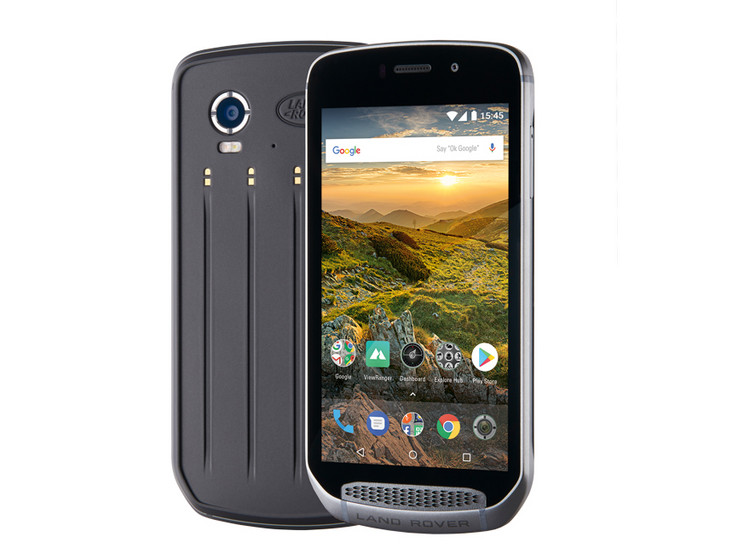
People who drive Land Rovers tend to love the great outdoors and may want a smartphone to accompany them on their adventures in the wild. This appears to be what the auto manufacturer was thinking, at any rate. With the help of the Bullitt Group, the car brand is now making its debut in the smartphone market. Bullitt is also known as the manufacturer of the robust CAT smartphones and the Kodak Ektra. The first smartphone released by the car brand is the Land Rover Explore, a rugged outdoor smartphone that bears a striking similarity to the company's automotive designs. The unique feature: The smartphone comes with a so-called "Adventure Pack", a module with a larger GPS antenna and an extra battery that can be attached to the back of the device with a magnet. More expansion packs are allegedly to come, converting the Land Rover Explore into a super-customizable outdoor phone.
The Land Rover smartphone is no budget device—the recommended retail price is a whopping 699 Euros (~$800). Our database is mostly populated with reviews of less expensive ruggedized smartphones. However, the difference in price may not necessarily be related to hardware configuration—after all, the Land Rover Explore comes with this mighty Adventure Pack. In the end, we chose three rugged devices for comparison: the Ulefone Armor X, the Blackview BV9000 Pro and the Samsung Galaxy XCover 4.
Case - Pressure-sensitive front on the Land Rover Explore
The Land Rover Explore is, of course, IP68 water- and dust-resistant, as is only befitting of a rugged smartphone. The case design is inspired by the Land Rover off-road vehicle. For example, the speaker grille on the front mimics the grille on the front of a car. The case is surrounded by a hefty metal frame. The display is protected not only by a raised frame, but the manufacturer also seals the display with a protective film in the factory. At a thickness of 14 mm (0.55 inches), the Land Rover phone has a pretty bulky build, but less so than many ruggedized phones from China. The case is very stable: It cannot be twisted, and applying pressure to the back side does not affect the smartphone. However, pressing on the front causes faint ripples to appear on the display.
64 GB of mass storage and 4 GB of RAM make sense for a mid-range smartphone. The storage space can be expanded with a microSD card, though the user then forfeits one of the two dual SIM slots. The manufacturer does not specify the maximum capacity of the microSD card, but the Land Rover Explore had no trouble with our 64 GB card. The card can be formatted as internal or external storage. Note: Apps cannot be stored on an external storage medium.
The USB Type-C connection on the bottom edge of the device gets by without a protective cover, transfers data at USB 2.0 speeds, and it supports USB OTG.
Software - Many outdoor apps come preinstalled on the Land Rover phone
The manufacturer chose to install pure Android 7.1.1 OS on the Land Rover Explore. An update to Android 8 is to follow. The security patches on our test device are dated from the beginning of May 2018, meaning they will need to be updated in the near future.
The Land Rover phone also comes with copious preinstalled software: In addition to the star chart app and the usual Strava and ViewRanger apps for outdoor enthusiasts, there is also a geocaching app. To the irritation of some users, the smartphone also comes with some advertising apps from Facebook preinstalled. Those who just want pure Android will first need to delete several apps, but anyone who uses outdoor apps will not have to install them.
Communication and GPS - Few LTE bands and additional GPS antenna in the Land Rover Explore
The Land Rover Explore supports the fast WLAN standard 802.11 ac, at least according to the spec sheet—our speed measurements with our Linksys EA8500 reference router seem to contradict this claim: In our tests, the Land Rover Explore only reached data transfer speeds on par with 802.11 n devices and is substantially slower than the Ulefone Armor X and the Blackview BV9000 Pro.
With just five supported LTE bands, only the basic necessities are on board. That is a shame for a phone you might want to take on a hiking trip in a far-away land. It is questionable whether users will be able to join an LTE network abroad. The reception was quite good in our well-developed German D2 network: Even indoors, we always had at least two bars of LTE reception.
| Networking | |
| iperf3 transmit AX12 | |
| Ulefone Armor X | |
| Blackview BV9000 Pro | |
| Land Rover Explore | |
| Samsung Galaxy XCover 4 | |
| iperf3 receive AX12 | |
| Blackview BV9000 Pro | |
| Ulefone Armor X | |
| Land Rover Explore | |
| Samsung Galaxy XCover 4 | |
An additional GPS ceramic patch antenna in the Adventure Pack is intended to improve GPS location services. However, our results from the GPS Test app show no difference between the device's capabilities on its own compared with the Adventure Pack attached. In general, the Land Rover Explore does a very good job where location services are concerned; it only had trouble positioning us indoors. Near a window and outdoors, the smartphone could ascertain its position with a very good accuracy level of up to 3 meters. Positioning with Google Maps, however, proves not to be as exact as we would like—other smartphones do a better job here.
The Land Rover smartphone completed our practical test, a bike tour with a Garmin Edge 520 professional navigator as a reference device, with the Adventure Pack attached. It recorded our path well—almost as precisely as the Garmin device. In everyday use, the smartphone should be well-suited for navigation tasks, though the lower level of accuracy in Google Maps worries us somewhat.
Phone Function and Call Quality - Good clarity
Android's standard phone app serves as the interface for making calls.
The speech quality is good, and the earpiece's maximum volume is quite high. Faint background noises mix with the sound of the conversation partner's voice, but they are not loud enough to be bothersome. At lower volumes, the background noises disappear. The microphone's recording of our voice was quite clear, regardless how loudly or quietly we spoke. The speech quality is also good over the speakerphone, though it has trouble with quiet voices.
Cameras - Moderate photo quality
The Land Rover Explore has single cameras on the front and back of the device. The camera on the back side is recessed slightly into the case for extra protection. The camera sensor has a resolution of 16 megapixels and is supported by a dual LED flash. Overall, the photo quality is reasonable—finer details are often captured cleanly, though bright areas sometimes bloom. Our flowers' red petals have little in the way of definition. The snapshot of our surrounding environment is more satisfactory. In low light, both the illumination and the reproduction of details are reasonably good but by no means on par with the results achieved by high-end smartphones.
Videos can be recorded at a maximum of 1080p and 30 fps. Here, the camera tends slightly toward a softer focus, and the autofocus does not always react as quickly as we would like. On the other hand, the camera adjusts for lighting without any visible gradation, and overall the level of detail is quite good.
The Land Rover Explore's front camera has a resolution of 8 megapixels. Its photos could stand to have more details, and bright areas bloom somewhat here as well. On the whole, however, this camera's imaging performance is also reasonably good.
The camera performance in the regulated lighting conditions in our laboratory is also good: Colored areas look somewhat grainy, but lines are crisp and text on colored backgrounds is cleanly contrasted. The color reproduction is somewhat too dark in most cases.
Accessories and Warranty - Land Rover Explore with lots of accessories
In addition to the hefty Adventure Pack with its extra battery and improved GPS antenna, the Land Rover's box contains a protective cover. The cover only fits properly when the Adventure Pack is attached. A special carabiner can clip to the back of the case—conveniently, just such a carabiner also comes in the box. A quick-charge device, USB cable and SIM ejector tool round off the set of accessories. Buyers can also purchase a battery pack that connects to the back of the Land Rover Explore, much like the Adventure Pack. The price of the battery pack is currently unknown.
The smartphone comes with a 24-month warranty in the EU. Please see our Guarantees, Return policies and Warranties FAQ for country-specific information.
Input Devices and Operation - Optional glove mode
The Land Rover phone uses Google's GBoard as its keyboard app, which comes standard on the Android OS. This keyboard enables users to type fluidly and offers several additional features and settings options.
The touchscreen is very sensitive in every area and is easy to operate. The menu buttons are located on the display; the left side of the case houses the big ribbed hardware buttons for volume and standby. They are comfortable to use and have a clear click point. The touchscreen also has a glove mode.
The option to operate the device with touchscreen gestures or movements does not come preinstalled on the smartphone.
Display - Land Rover Explore with bright screen
| |||||||||||||||||||||||||
Brightness Distribution: 91 %
Center on Battery: 633 cd/m²
Contrast: 754:1 (Black: 0.84 cd/m²)
ΔE ColorChecker Calman: 6.41 | ∀{0.5-29.43 Ø4.78}
ΔE Greyscale Calman: 9.2 | ∀{0.09-98 Ø5}
97.7% sRGB (Calman 2D)
Gamma: 1.927
CCT: 6165 K
| Land Rover Explore IPS, 1920x1080, 5" | Samsung Galaxy XCover 4 IPS, 1280x720, 5" | CAT S40 IPS, 960x540, 4.7" | Blackview BV9000 Pro IPS, 1440x720, 5.7" | Ulefone Armor X IPS, 1440x720, 5.5" | |
|---|---|---|---|---|---|
| Screen | -3% | 26% | 16% | 27% | |
| Brightness middle (cd/m²) | 633 | 445 -30% | 607 -4% | 621 -2% | 564 -11% |
| Brightness (cd/m²) | 604 | 437 -28% | 579 -4% | 598 -1% | 541 -10% |
| Brightness Distribution (%) | 91 | 88 -3% | 90 -1% | 91 0% | 91 0% |
| Black Level * (cd/m²) | 0.84 | 0.67 20% | 0.5 40% | 0.64 24% | 0.37 56% |
| Contrast (:1) | 754 | 664 -12% | 1214 61% | 970 29% | 1524 102% |
| Colorchecker dE 2000 * | 6.41 | 6.5 -1% | 4.25 34% | 5.5 14% | 5.1 20% |
| Colorchecker dE 2000 max. * | 11.88 | 10.6 11% | 10 16% | 9.6 19% | |
| Greyscale dE 2000 * | 9.2 | 7.2 22% | 4.09 56% | 5.1 45% | 5.4 41% |
| Gamma | 1.927 114% | 2.53 87% | 2.61 84% | 2.52 87% | 2.1 105% |
| CCT | 6165 105% | 8274 79% | 6959 93% | 7362 88% | 7755 84% |
| Color Space (Percent of AdobeRGB 1998) (%) | 71.2034 | ||||
| Color Space (Percent of sRGB) (%) | 94.1292 |
* ... smaller is better
Screen Flickering / PWM (Pulse-Width Modulation)
| Screen flickering / PWM detected | 79 Hz | ≤ 20 % brightness setting | |
The display backlight flickers at 79 Hz (worst case, e.g., utilizing PWM) Flickering detected at a brightness setting of 20 % and below. There should be no flickering or PWM above this brightness setting. The frequency of 79 Hz is very low, so the flickering may cause eyestrain and headaches after extended use. In comparison: 53 % of all tested devices do not use PWM to dim the display. If PWM was detected, an average of 8108 (minimum: 5 - maximum: 343500) Hz was measured. | |||
Unfortunately, the black value (0.84 cd/m²) fails to impress and leaves the smartphone with a less than stellar contrast ratio of 754:1. As a result, colors on the display are not as brilliant as we would wish. At less than 20% brightness, we measured a substantial display flicker that could cause problems for some people. Sensitive users may want to try out the Land Rover at low brightness in the store before purchasing this device.
In our test with a spectrophotometer and the CalMAN software, we established that the display has a slight green cast. We also found that the display's color accuracy is somewhat less precise than those of our comparison devices.
Display Response Times
| ↔ Response Time Black to White | ||
|---|---|---|
| 18 ms ... rise ↗ and fall ↘ combined | ↗ 5 ms rise | |
| ↘ 13 ms fall | ||
| The screen shows good response rates in our tests, but may be too slow for competitive gamers. In comparison, all tested devices range from 0.1 (minimum) to 240 (maximum) ms. » 39 % of all devices are better. This means that the measured response time is better than the average of all tested devices (20.2 ms). | ||
| ↔ Response Time 50% Grey to 80% Grey | ||
| 36 ms ... rise ↗ and fall ↘ combined | ↗ 15 ms rise | |
| ↘ 21 ms fall | ||
| The screen shows slow response rates in our tests and will be unsatisfactory for gamers. In comparison, all tested devices range from 0.165 (minimum) to 636 (maximum) ms. » 49 % of all devices are better. This means that the measured response time is worse than the average of all tested devices (31.6 ms). | ||
Performance - Fast, but expensive
The Helio X27 SoC is not exactly common in our neck of the woods and belongs to the class of upper mid-range chips. As a result, the Land Rover Explore usually takes first place in our benchmarks compared to the rest of the devices on our list. The ARM Mali T880 MP4 graphics unit also provides considerably more performance power than the GPUs in our comparison devices.
| AnTuTu v6 - Total Score (sort by value) | |
| Land Rover Explore | |
| Samsung Galaxy XCover 4 | |
| Blackview BV9000 Pro | |
| Ulefone Armor X | |
| Average MediaTek Helio X27 MT6797X (n=1) | |
| AnTuTu v7 - Total Score (sort by value) | |
| Land Rover Explore | |
| Ulefone Armor X | |
| Average MediaTek Helio X27 MT6797X (105872 - 110854, n=4) | |
| PCMark for Android | |
| Work performance score (sort by value) | |
| Land Rover Explore | |
| Samsung Galaxy XCover 4 | |
| CAT S40 | |
| Blackview BV9000 Pro | |
| Ulefone Armor X | |
| Average MediaTek Helio X27 MT6797X (4922 - 5984, n=4) | |
| Work 2.0 performance score (sort by value) | |
| Land Rover Explore | |
| Samsung Galaxy XCover 4 | |
| Blackview BV9000 Pro | |
| Ulefone Armor X | |
| Average MediaTek Helio X27 MT6797X (4077 - 4695, n=4) | |
| GFXBench 3.1 | |
| on screen Manhattan ES 3.1 Onscreen (sort by value) | |
| Land Rover Explore | |
| Samsung Galaxy XCover 4 | |
| Blackview BV9000 Pro | |
| Ulefone Armor X | |
| Average MediaTek Helio X27 MT6797X (6.2 - 13, n=4) | |
| Average of class Smartphone (11 - 166, n=159, last 2 years) | |
| 1920x1080 Manhattan ES 3.1 Offscreen (sort by value) | |
| Land Rover Explore | |
| Samsung Galaxy XCover 4 | |
| Blackview BV9000 Pro | |
| Ulefone Armor X | |
| Average MediaTek Helio X27 MT6797X (12 - 13, n=4) | |
| Average of class Smartphone (8.4 - 413, n=158, last 2 years) | |
The Land Rover Explore is one of the fastest competitors for surfing the Internet—though users will still have to wait for media content from time to time.
| JetStream 1.1 - Total Score | |
| Land Rover Explore (Chrome 67) | |
| Average MediaTek Helio X27 MT6797X (29.9 - 48.9, n=4) | |
| Blackview BV9000 Pro (Chrome Mobile 53) | |
| Samsung Galaxy XCover 4 (Chrome 58) | |
| Ulefone Armor X (Chrome 66) | |
| Octane V2 - Total Score | |
| Average of class Smartphone (2228 - 121337, n=201, last 2 years) | |
| Land Rover Explore (Chrome 67) | |
| Average MediaTek Helio X27 MT6797X (5909 - 9798, n=4) | |
| Blackview BV9000 Pro (Chrome Mobile 53) | |
| Ulefone Armor X (Chrome 66) | |
| Samsung Galaxy XCover 4 (Chrome 58) | |
| CAT S40 (Google Chrome 43.0.2357.93) | |
| Mozilla Kraken 1.1 - Total | |
| CAT S40 (Google Chrome 43.0.2357.93) | |
| Blackview BV9000 Pro (Chrome Mobile 53) | |
| Ulefone Armor X (Chrome 66) | |
| Samsung Galaxy XCover 4 (Chrome 58) | |
| Average MediaTek Helio X27 MT6797X (4261 - 9851, n=4) | |
| Land Rover Explore (Chrome 67) | |
| Average of class Smartphone (257 - 28190, n=156, last 2 years) | |
| WebXPRT 2015 - Overall | |
| Land Rover Explore (Chrome 67) | |
| Average MediaTek Helio X27 MT6797X (n=1) | |
| Samsung Galaxy XCover 4 (Chrome 58) | |
| CAT S40 (Google Chrome 43.0.2357.93) | |
* ... smaller is better
With our Toshiba Exceria Pro M501 reference microSD card, the Land Rover smartphone reached normal transfer rates. The internal eMMC storage medium's transfer rates are also typical. Compared to other devices in the Land Rover Explore's price range, these transfer rates are actually somewhat slow. On today's market, high-end smartphones are often equipped with much faster UFS 2.1 storage devices.
| Land Rover Explore | Samsung Galaxy XCover 4 | CAT S40 | Blackview BV9000 Pro | Ulefone Armor X | Average 64 GB eMMC Flash | Average of class Smartphone | |
|---|---|---|---|---|---|---|---|
| AndroBench 3-5 | -16% | -45% | 40% | -12% | 65% | 1581% | |
| Sequential Read 256KB (MB/s) | 237.3 | 181.6 -23% | 137.9 -42% | 244.7 3% | 255.3 8% | 277 ? 17% | 2226 ? 838% |
| Sequential Write 256KB (MB/s) | 104.5 | 73.6 -30% | 64.3 -38% | 174.6 67% | 82.8 -21% | 178.4 ? 71% | 1848 ? 1668% |
| Random Read 4KB (MB/s) | 28.7 | 21.8 -24% | 14.93 -48% | 72.6 153% | 14.7 -49% | 60.7 ? 111% | 295 ? 928% |
| Random Write 4KB (MB/s) | 11.2 | 11.9 6% | 5.39 -52% | 12.72 14% | 10.17 -9% | 33.8 ? 202% | 335 ? 2891% |
| Sequential Read 256KB SDCard (MB/s) | 75.2 ? | 69 ? -8% | 76.7 ? 2% | 81.5 ? 8% | 77.4 ? 3% | ||
| Sequential Write 256KB SDCard (MB/s) | 66.3 ? | 55.7 ? -16% | 68.5 ? 3% | 62.6 ? -6% | 58.3 ? -12% |
Games - The Land Rover Explore is good for gaming
For those who are recovering from a recent mountain-climbing adventure it is also possible to play games on the Land Rover Explore. Even brand-new games, such as the freshly released Asphalt 9, run smoothly—though the frame rate comes in at just below 30 fps. PUBG Mobile stutters on occasion; Shadow Fight 3, on the other hand, runs flawlessly above 30 fps. Ultimately, the Land Rover Explore is not the perfect gaming device, but it can certainly please users with intermediate requirements.
Touchscreen- and position sensor-based controls worked perfectly in our tests.
| PUBG Mobile | |||
| Settings | Value | ||
| Smooth | 25 fps | ||
| Balanced | 24 fps | ||
| Shadow Fight 3 | |||
| Settings | Value | ||
| high | 42 fps | ||
| minimal | 42 fps | ||
| Asphalt 9: Legends | |||
| Settings | Value | ||
| High Quality | 29 fps | ||
| Standard / low | 29 fps | ||
Emissions - Land Rover Explore with front speaker
We measured a maximum temperature of 43.1 °C (109.6 °F) on the Land Rover Explore's case. This temperature is acceptable but could prove to be uncomfortably warm in the summer. In idle mode, the smartphone warms slightly to a maximum of 33.3 °C (91.9 °F), though this level of warmth is hardly palpable.
(±) The maximum temperature on the upper side is 43.1 °C / 110 F, compared to the average of 35.2 °C / 95 F, ranging from 21.9 to 247 °C for the class Smartphone.
(±) The bottom heats up to a maximum of 43.1 °C / 110 F, compared to the average of 34 °C / 93 F
(±) In idle usage, the average temperature for the upper side is 32.7 °C / 91 F, compared to the device average of 32.9 °C / 91 F.
Speaker
The speaker on the front can hardly be overlooked, given that it is covered with a large grille designed to mimic the grille on the front of Land Rover cars. The sound is good and reasonably loud. High tones are somewhat overrepresented, which can be bothersome at high volumes. Low mid-tones are present, though somewhat less audible than on high-end smartphones.
Speakers or headphones can be connected via Bluetooth or plugged into the 3.5 mm jack. Both function flawlessly and plugs hold securely in the jack.
Land Rover Explore audio analysis
(±) | speaker loudness is average but good (78.4 dB)
Bass 100 - 315 Hz
(-) | nearly no bass - on average 25.2% lower than median
(±) | linearity of bass is average (7.1% delta to prev. frequency)
Mids 400 - 2000 Hz
(+) | balanced mids - only 4.5% away from median
(+) | mids are linear (5.6% delta to prev. frequency)
Highs 2 - 16 kHz
(±) | higher highs - on average 6.7% higher than median
(+) | highs are linear (4.7% delta to prev. frequency)
Overall 100 - 16.000 Hz
(±) | linearity of overall sound is average (25.2% difference to median)
Compared to same class
» 62% of all tested devices in this class were better, 7% similar, 32% worse
» The best had a delta of 11%, average was 35%, worst was 134%
Compared to all devices tested
» 77% of all tested devices were better, 5% similar, 18% worse
» The best had a delta of 4%, average was 24%, worst was 134%
Samsung Galaxy XCover 4 audio analysis
(±) | speaker loudness is average but good (80.4 dB)
Bass 100 - 315 Hz
(-) | nearly no bass - on average 15.9% lower than median
(±) | linearity of bass is average (12.3% delta to prev. frequency)
Mids 400 - 2000 Hz
(±) | higher mids - on average 7.4% higher than median
(+) | mids are linear (5.1% delta to prev. frequency)
Highs 2 - 16 kHz
(±) | higher highs - on average 6.3% higher than median
(+) | highs are linear (6.3% delta to prev. frequency)
Overall 100 - 16.000 Hz
(±) | linearity of overall sound is average (24.2% difference to median)
Compared to same class
» 56% of all tested devices in this class were better, 7% similar, 37% worse
» The best had a delta of 11%, average was 35%, worst was 134%
Compared to all devices tested
» 72% of all tested devices were better, 6% similar, 22% worse
» The best had a delta of 4%, average was 24%, worst was 134%
Battery Life - Mediocre battery life, except with additional pack
Turned off or in standby, the smartphone's energy consumption is quite low. The maximum power usage in idle mode, on the other hand, is rather high (3 watts). The bright display explains this disparity. 8.6 watts under maximum load is also the highest energy consumption rate among our comparison list.
| Off / Standby | |
| Idle | |
| Load |
|
Key:
min: | |
| Land Rover Explore 4000 mAh | Samsung Galaxy XCover 4 2800 mAh | CAT S40 mAh | Blackview BV9000 Pro 4180 mAh | Ulefone Armor X 5500 mAh | Average MediaTek Helio X27 MT6797X | Average of class Smartphone | |
|---|---|---|---|---|---|---|---|
| Power Consumption | 24% | 8% | 2% | 3% | -85% | -2% | |
| Idle Minimum * (Watt) | 1.2 | 0.56 53% | 1.2 -0% | 1.04 13% | 1.22 -2% | 2.37 ? -98% | 0.848 ? 29% |
| Idle Average * (Watt) | 1.5 | 1.57 -5% | 2 -33% | 2.14 -43% | 2.07 -38% | 4.35 ? -190% | 1.434 ? 4% |
| Idle Maximum * (Watt) | 3 | 1.68 44% | 2.1 30% | 2.17 28% | 2.14 29% | 4.82 ? -61% | 1.618 ? 46% |
| Load Average * (Watt) | 4.5 | 4.6 -2% | 4.3 4% | 5.11 -14% | 4.92 -9% | 6.52 ? -45% | 7.01 ? -56% |
| Load Maximum * (Watt) | 8.6 | 5.92 31% | 5.3 38% | 6.37 26% | 5.4 37% | 11.3 ? -31% | 11.3 ? -31% |
* ... smaller is better
Battery Life
At 8:49 hours, the Land Rover Explore's battery life in our WLAN test is not spectacular—but if you connect the hefty Adventure Pack with a full charge, the smartphone easily lasts a good 19 hours here.
The quick-charge device included in the Land Rover's box fully charges the smartphone in less than 2 hours. The Adventure Pack has its own power connection and needs to be charged separately from the smartphone.
| Land Rover Explore 4000 mAh | Samsung Galaxy XCover 4 2800 mAh | CAT S40 mAh | Blackview BV9000 Pro 4180 mAh | Ulefone Armor X 5500 mAh | |
|---|---|---|---|---|---|
| Battery runtime | 26% | 16% | 10% | 60% | |
| WiFi v1.3 (h) | 8.8 | 11.1 26% | 10.2 16% | 9.7 10% | 14.1 60% |
| Reader / Idle (h) | 23.1 | 23.8 | 19 | ||
| H.264 (h) | 11.4 | 10.5 | |||
| Load (h) | 3.4 | 6.2 | 4.6 |
Pros
Cons
Verdict - Modular and practical for outdoors
Simply as a smartphone, cost-wise you could say that the Land Rover Explore does not offer enough for its price: Its performance is weaker than other smartphones in this price bracket, and its display seems a little too exposed to survive a serious tumble unscathed. The battery life leans toward the mediocre, and the camera is no better than average. But the Land Rover Explore comes with a ton of accessories, and that makes all the difference. With its Adventure Pack, the Land Rover Explore converts into a behemoth in the realm of battery life—but it also weighs a total of 356 grams (0.78 lbs) and is quite bulky. The integrated GPS antenna did very well in our practical test, but the lack of precision in Google Maps is irritating.
The Land Rover Explore is a well-designed rugged smartphone with lots of accessories.
If desired, the display can get very bright, and you can operate the screen with gloves on. The device is water- and dust-proof and offers all the important functions you need from a ruggedized smartphone. The lack of protective covers on the connections could prove to be a problem—imagine needing to clean out the USB port after a mud bath. Because the manufacturer plans to release many exciting expansions for the Land Rover Explore—all of which will connect via the docking port on the back of the device—lovers of the great outdoors will probably find it worthwhile to take a closer look.
Land Rover Explore
- 10/16/2019 v7 (old)
Florian Wimmer




